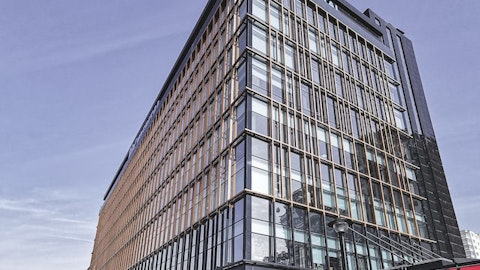Omega Healthcare Investors, Inc. (NYSE:OHI) Q4 2023 Earnings Call Transcript February 8, 2024
Omega Healthcare Investors, Inc. isn’t one of the 30 most popular stocks among hedge funds at the end of the third quarter (see the details here).
Operator: Greetings and welcome to the Omega Healthcare Investors Fourth Quarter 2023 Earnings Conference Call. [Operator Instructions] As a reminder, this conference is being recorded. I will now turn the conference over to Michele Reber. You may begin.
Michele Reber: Thank you and good morning. With me today is Omega’s CEO, Taylor Pickett; COO, Dan Booth; CFO, Bob Stephenson; and Megan Krull, Senior Vice President of Operations. Comments made during this conference call that are not historical facts maybe forward-looking statements such as statements regarding our financial projections, potential transactions, operator prospects and outlook generally. Factors that could cause actual results to differ materially from those in the forward-looking statements are detailed in the company’s filings with the SEC. During the call today, we will refer to some non-GAAP financial measures, such as NAREIT FFO, adjusted FFO, FAD and EBITDA. Reconciliations of these non-GAAP measures to the most comparable measure under generally accepted accounting principles are available in the quarterly supplement.
In addition, certain operator coverage and financial information that we discuss is based on data provided by our operators that has not been independently verified by Omega. I will now turn the call over to Taylor.
Taylor Pickett: Thanks, Michele. Good morning and thank you for joining our fourth quarter 2023 earnings conference call. Today, I will discuss our fourth quarter financial results and certain key operating trends. Fourth quarter FAD funds available for distribution of $0.64 per share was as expected, reflecting several portfolios that are in the process of being transitioned, which will result in meaningful FAD upside over the next few quarters. Full year FAD was $2.62 per share, slightly below our full year dividend of $2.68 per share, resulting in a payout ratio of 102%. We continue to have a handful of cash basis operators, including Maplewood that will impact our go-forward AFFO and FAD, making first quarter 2024 FAD difficult to predict.
However, longer term, we believe all of these assets, but in particular, Maplewood, are well positioned to generate reliable and growing cash flows and related rent. We believe that we have enough visibility into the timing and ultimate resolution of the portfolios that are being transitioned or sold to provide guidance for the first time since the pandemic started. Our 2024 AFFO guidance is between $2.70 and $2.80 per share. As Dan will discuss, key tenant occupancy and rent coverage metrics continue to improve, including the under 1x EBITDAR coverage operator metric, which dropped from 27.5% of total rent to 13.2% of total rent. We can break the 13.2% into a handful of buckets; operators representing 7.5% of the 13.2%, our strong credits and therefore, payment of rent should not be an issue.
Operators representing 1.2% at third quarter and October EBITDAR coverage above 1.0x, benefiting from state rate increases and operational improvements that we expect to continue on a go-forward basis. 0.9% represents facilities that have already transitioned to performing credit. That leaves operators representing 3.6%, of which an operator representing 0.5% was recently transitioned, which leaves a balance of 3.1%, representing 11 small operating relationships. I will now turn the call over to Bob.
Bob Stephenson: Thanks, Taylor and good morning. Turning to our financials for the fourth quarter. Revenue for the fourth quarter was $239 million before adjusting for certain non-recurring items compared to $145 million for the fourth quarter of 2022. The year-over-year increase is primarily a result of timing related to operator restructurings, revenue from new investments completed in 2022 and ‘23 and net straight-line write-offs, partially offset by asset sales completed during that same time period. Our NAREIT FFO for the fourth quarter was $129 million or $0.50 per share as compared to a loss of $30 million or a loss of $0.13 per share for the fourth quarter of 2022. Our adjusted FFO was $173 million or $0.68 per share for the quarter, and our FAD was $163 million or $0.64 per share and both exclude several items consistent with historical practices and outlined in our NAREIT FFO, adjusted FFO and FAD reconciliations to net income found in our earnings release, as well as our fourth quarter financial supplemental posted to our website.
Our balance sheet continues to remain strong. In the fourth quarter, we repaid 25 HUD mortgages totaling $227 million, these repayments stemmed from the previously disclosed LaVie asset sales and transitions. We ended the quarter with over $440 million of cash on the balance sheet and over $1.4 billion in credit facility borrowing capacity and are well positioned to pay off our April 1, $400 million bond maturity and fund new investments. As of year end, 99% of our $5.1 billion in debt was at fixed rates and our net funded debt to annualized adjusted normalized EBITDA was 4.96x and our fixed charge coverage ratio was 3.8x. As Taylor mentioned, for the first time since the start of the pandemic, we are providing full year adjusted FFO guidance of between $2.70 to $2.80 per share.
We are assuming no change in our revenue related to operators currently on an accrual basis of revenue recognition or stated another way, no additional operators being placed on a cash basis for revenue recognition. We are assuming a timely completion of operator restructurings, which includes both the LaVie and Guardian portfolios and Maplewood’s eventual return to full contractual rent. We are assuming $94 million in asset sales related to the facilities classified as held-for-sale as of year end. We have included the annual impact of new investments completed in 2023 as well as $27 million of new investments completed year-to-date. We project our quarterly G&A expense to run between $11.5 million to $13.5 million per quarter, with the first quarter typically being the highest.
Non-cash stock-based compensation expense, which is included in NAREIT FFO but eliminated in our adjusted FFO, is estimated to be approximately $9.2 million per quarter. We assumed the repayment of our April 1 $400 million bond maturity. We assume no material changes in market interest rates as it relates to either the overnight investment rates earned on balance sheet cash or interest expense charge on credit facility borrowings. Our 2024 adjusted FFO guidance excludes any additional new investments or asset sales as well as any additional capital transactions other than what was already mentioned. As several operator transitions are still in negotiations and the precise timing is unknown, we provided a wide range to our adjusted FFO guidance.

As stated in yesterday’s earnings press release, in the fourth quarter, LaVie paid $5.3 million in rent. And in January, LaVie paid approximately $1.45 million from rent. We utilized Guardian’s $4.4 million security deposit to record fourth quarter rent. The remaining $60,000 in security deposit was exhausted in January and no additional cash rent was received from Guardian in January. And lastly, we recorded $11.6 million in Maplewood revenue in the fourth quarter through a combination of cash and security deposit applications. In January, Maplewood paid $3.8 million in rent. Dan will provide additional color on these operators in his prepared remarks. And with that, I will turn the call over to Dan.
Dan Booth: Thanks, Bob and good morning everyone. As of the December 31, 2023, Omega had an operating asset portfolio of 862 facilities, with approximately 84,000 operating beds. These facilities were spread across 69 third-party operators and located within 42 states in the United Kingdom. Trailing 12-month operator EBITDAR coverage for our core portfolio as of September 30, 2023, increased to 1.28x versus 1.15x for the trailing 12-month period ended June 30, 2023. During the third quarter of 2023, our operators cumulatively recorded approximately $12 million in federal stimulus funds as compared to approximately $13.2 million recorded during the second quarter. Trailing 12-month operator EBITDAR coverage would have increased during the third quarter of 2023 to 1.21x as compared to 1.07x for the second quarter when excluding the benefit of any federal stimulus funds.
EBITDAR coverage for the standalone quarter ended September 30, 2023 for our core portfolio was 1.33x, including federal stimulus and 1.27x, excluding the $12 million of federal stimulus funds. This compares favorably to the standalone second quarter of 1.21x and 1.15x with and without $13.2 million in federal stimulus funds respectively. Occupancy for our overall core portfolio has continued to recover from a low of 74.6% in January of 2022 to 80.2% as of mid-January 2024 based upon preliminary reporting from our operators. For comparative purposes, occupancy for our core portfolio was 83.2% for the fourth quarter of 2019 just prior to the onset of the COVID pandemic. Turning to portfolio matters. LaVie, in the fourth quarter of 2023, Omega sold a total of 30 LaVie facilities for $317.9 million of gross proceeds.
All of the facilities were located in Florida. Omega is currently in the process of transitioning 6 additional facilities, 4 in Louisiana and 2 in Florida to third-party operators. Omega’s remaining portfolio with LaVie will consist of 30 facilities, which include 13 facilities in North Carolina, 9 in Pennsylvania, 6 in Mississippi and 2 in Virginia. 3 of those 4 states are considered highly desirable from an operating environment standpoint. We are currently in ongoing discussions with LaVie on the best overall future for each of these remaining 30 facilities. LaVie has paid approximately $1.45 million per month for the last 3 months, including January of 2024. Maplewood. During the fourth quarter of 2023, Maplewood paid rent of $11.6 million, consisting of $9.8 million of cash payments and $1.8 million in security deposit applications.
In January of 2024, Maplewood paid $3.8 million in rent. Maplewood continues to see strong performance across the portfolio with 16 of the 17 facilities fully stabilized. Occupancy at inspired New York City is currently at 65%. And Maplewood believes there is a path to stabilization at the facility in the near future. Maplewood was recently awarded Best of Senior Living Awards at all 17 facilities, which places the communities in the top 1% to 2% of senior housing care providers nationwide. This remarkable achievement reflects the dedication and commitment of the Maplewood employees. Guardian. Omega currently leases 6 facilities to Guardian, 5 in Pennsylvania and 1 in West Virginia. We are currently negotiating lease terms to re-lease the remaining 6 facilities to an unrelated third-party subject to normal regulatory approvals and the finalization of certain documentation.
In addition to the aforementioned restructurings and transitions, Omega is working with several other relatively small operators on various restructurings. Turning to new investments. During the fourth quarter of 2023, Omega completed a total of $249 million in new investments, consisting of $167 million in real estate loans and other loans, $51 million in real estate acquisitions and $31 million in capital expenditures. These new loans have a weighted average interest rate of 10.5%. The new acquisitions have a weighted average annual yield of 9%, with 2.5% annual escalators. During the full year of 2023, Omega made new investments totaling $667 million, including $84 million in capital expenditures. Subsequent to year end 2023, Omega has closed on $27 million in new mortgage loans.
These new loans completed in 2024, have a weighted average interest rate of 9.6%. Turning to dispositions. During the fourth quarter of 2023, Omega sold 32 facilities for $324 million. During the full year of 2023, Omega sold 69 facilities for $485 million. I will now turn the call over to Megan.
Megan Krull: Thanks, Dan and good morning everyone. There continues to be positive momentum on the staffing front, albeit with wide variation by market. Agency expense on a per patient day basis for our core portfolio for third quarter 2023 dropped to 3x where it was in 2019 in comparison to the 4x we reported last quarter and the 5x we reported two quarters ago. And as expected, with the staffing shortages easing, we see occupancy continue to slowly improve with a slight slowdown in the winter months as is typical. The number of core facilities recovered is now at 42%, up from the 37% reported in the second quarter. Additionally, 22% of core facilities that have not yet fully recovered are at or above 84% occupancy. Overshadowing these improvements, however, is the promise by CMS that they will finalize the staffing mandate sometime this year.
This was not entirely unexpected given the current administration had promised its implementation. Despite the long-term impact that this could have on the industry, especially if left unfunded, the impact is negligible in the near-term. Recall that the mandate as currently proposed is already slated to have a delayed implementation with the 24/7 RN requirement going into effect 2 years after the mandate is finalized for urban facilities and 3 years for rural and the required hours per resident day for RNs and nursing aids going into effect 3 years after the mandate is finalized for urban facilities in 5 years for rural. With AHCA’s strong track record in getting improvements made to proposed rules, and more than 40,000 comments received by CMS, all of which need to be reviewed and considered, it is too soon to tell what the ultimate mandate will look like.
We can only hope that reasonable minds will prevail and then any final mandate will be well balanced. And of course, we also need to remember that a lot can happen in 2 years when the first impact is currently proposed is slated to occur. There is always the potential that additional rulemaking or legislation will change the final rule substantially within that time, not to mention the possibility that legislation could block the mandate altogether, with bipartisan legislation already introduced in Congress to do just that. I will now open the call up for questions.
See also 15 States with the Cheapest Car Insurance In The US and 25 Best States for Job Seekers Right Now.
Q&A Session
Follow Omega Healthcare Investors Inc (NYSE:OHI)
Follow Omega Healthcare Investors Inc (NYSE:OHI)
Receive real-time insider trading and news alerts
Operator: Thank you. [Operator Instructions] And our first question comes from the line of Jonathan Hughes from Raymond James. Please proceed with your question.
Jonathan Hughes: Hi, good morning. Thanks for the time. On the fourth quarter acquisitions, I see the initial cash yields were 9%. Can you just share if those were snaps or seniors housing? And then maybe what yields you’re underwriting on the current investment pipeline?
Dan Booth: Yes. So most of the yields that we’re underwriting to over 10% or even north or all the fourth quarter yields on those – the investments that you highlighted were 9%. Some of those deals were a long time in the making, has been in the pipeline for a while. So we had a quarter a price some quarters back. The overall yield for the year is north of 10%. I think it’s 10.4% blended. So – and that’s pretty much what we’re quoting today is 10% in North.
Jonathan Hughes: Okay. And then that mix of investment activity over the past year, it’s been – you call it, 60% loan investments versus 40% acquisitions. And I guess the loan investments might be because you’re filling a void left by banks and those have been with existing relationships. But when do we see acquisitions pick up and comprise the majority of your investment activity?
Dan Booth: I think we still did a number of acquisitions, right? I’d say that that’s one of our same-store that we’ve done in prior years. I think we just have a pick up in loans, and as you said or kind of answering your own question, but it was just filling a void in the capital markets as they stand today, I mean, there is a lot of banks that aren’t active and we’re filling that void. We could continue to see that certainly in ‘24.
Jonathan Hughes: Okay. And maybe just one more for me. Can you share some details on the $50 million term loan made in December. What are use of proceeds? What is exposure to that operator and the EBITDAR coverage of that portfolio? And maybe why do such a short-term non-real estate investment? Thanks.
Dan Booth: Yes. So our relationship with that individual or companies that he controls is less than 1% of Omega rate. And just a couple of facts to highlight that relationship goes back for many, many years. Those individuals have been in the industry for over 35 years. Our world cross on multiple fronts, including the fact that we share multiple relationships. He has an excellent history. He is a high net worth and the investment was actually to allow him to make an investment in another company that he privately owns, and so it falls outside of any relationship we have in this world – in the SNF world. And it’s collateralized as well by the equity interest in that private investment. So it’s well collateralized, high net worth individual with great track record.
Jonathan Hughes: And then maybe – I don’t know if I heard you, but what’s maybe the coverage of that portfolio? I realize it’s close to 1%, but if you have that, that would be great.
Dan Booth: So I mean, we just generally don’t comment on individual operator coverages, so I’m not going to go there today, but I’ll just say that, we have been paying for probably 10 years plus on both those leases and they pay [indiscernible].
Jonathan Hughes: Alright. Appreciate the time.
Operator: Thank you. The next question is from the line of Vikram Malhotra with Mizuho. Please proceed with your question.
Vikram Malhotra: Good morning. Thanks for taking the questions. Maybe just to start off the guide. Could you give us some color on sort of what’s baked in at the low end versus the high end? And how we should think about sort of operator resolution and investments, both at the high end and low end?
Bob Stephenson: Yes. We returned to happily so our adjusted FFO guidance based on historical practices and gave a little bit wider range because we did mention we have LaVie and Guardian in the transition restructuring mode and Maplewood needs to return to paying full contractual rent. So at the low end, it means it takes a little bit longer on those transactions and the repayment on the high end, it’s just sooner. I mean it’s kind of that simple.
Vikram Malhotra: Got it. Okay. And then specifically for Maplewood, as you look through the year, you mentioned sort of you’re hoping as we go through the year, the return to more normal paying any assumptions you can share with us, one, just in terms of the Jan payment? Is that sort of a good run rate near-term? And then second, what are you assuming for occupancy of the New York asset as we go through the year for that normalized payment to occur?
Taylor Pickett: So, obviously, the January cash is a good run rate to start, but it doesn’t reflect the impact of rate increases for ‘24, which the Maplewood team expects to be 7% to 8% net. So that’s – we will see a pickup there as we start to march through the early part of the year, Vikram. And then the team is still working through some revisions on Second Avenue. The thought process now is they’ll be able to go from 65% into the 80s by year-end. But you have to remember that building has become a little bit mature in a competitive market now in Manhattan. So even though we might have 10 move-ins in a month, you’ll see 6 or 7 move out. So the net is – it’s real work to increase that occupancy over the next 10 months. Team hasn’t finalized their plan. We will probably have a lot more color on that for the next call.
Vikram Malhotra: Okay. Great. And then just, sorry, one – if I can just follow-up on the $50 million loan. It is sort of – it seems like a one-off. I just wanted to hear from your perspective if this is truly a one-off? And is there something strategic to it as well? Because it sounded like not kind of focused on real estate but more relationship based. So I just want to understand the kind of – is this truly something very unique. And then is there something else or strategic to it as well?
Dan Booth: Yes. I would say that this is more of a one-off than anything else. It’s not where we’re going to focus our attention.
Vikram Malhotra: Thank you.
Operator: Our next question is from the line of Michael Griffin with Citi. Please proceed with your question.
Michael Griffin: Great. Thanks. Just wanted to ask a question around occupancy. You said that in January, you’re seeing it north of 80%, but at the end of the year, it was about 79%. Given that we’re in a more seasonal time period, can you maybe just give some more color on why you’re seeing occupancy increase? Is it a function of some of these facilities being better staffed or anything you could provide there would be helpful.
Megan Krull: I think what we’re hearing from our operators is mostly the fact that the staffing is easing up, right? Some of the agency has come down. They are getting more permanent staff and they are building up their cultures again. And it’s just easier to have staff in the building and increase that occupancy. So that’s really what’s driving it.
Michael Griffin: Great. That’s helpful. And then just on the remaining LaVie assets in the portfolio. Is the plan to ultimately sell out of all of them and exit that relationship? Or do you see yourself kind of hanging on to some once the restructuring process comes to an end?
Taylor Pickett: Dan and his team are still in the middle of the discussions. So it’s – we don’t really have an answer for that. I will tell you, though, the important thing is, as Dan mentioned, those assets performed well. So if we never – chance they end up there is a lot of value there. It’s just a question of working through the process to make sure we maximize the value proposition.
Michael Griffin: Great. That’s it for me. Thanks for the time.
Operator: Our next question is from the line of Connor Siversky with Wells Fargo. Please proceed with your question.
Connor Siversky: Good morning out there. Thank you for the time. One on Maplewood, I’m curious what we should expect from the Washington, D.C. development when it rolls online next year. Do you have any sense of what that fixed cost load will look like once the doors are open? Is it reasonable to assume that opening that operation would impact Maplewood’s forward cash flow profile negatively? And then could you put any numbers around it at this time?




